Elizabeth Bell's Blog
May 15, 2024
The Language of Flowers
Like many a 19th-century novelist, I use the Language of Flowers throughout the Lazare Family Saga as part of my symbolism. I explain some of this floral code in my books, while other references are “Easter eggs.” In this post, I’ll unpack some of those meanings, and I’ll include illustrations in case the word “anemone” conjures a sea creature instead of a flower for you. (I’ll remove the character names for the big stuff, but SPOILERS ahead!)
The Language of Flowers, or floriography, dates back to ancient times, and Shakespeare uses it memorably in Ophelia’s mad scene. Floriography became especially popular during the Victorian era not only in England but also in the United States. The Language of Flowers is a way to send secret messages: only someone who knows what each flower signifies will understand the message. When you cannot express your love openly, you can say it with flowers!
The first thing I learned in my research is that any particular flower doesn’t have a single meaning but many. Sometimes the meanings change over time. Today, yellow roses mean friendship. In the Victorian era, they meant infidelity. Even 19th-century flower dictionaries often give contradictory meanings for the same flower.
As an author, I found this freeing. I could choose the meaning or meanings that made sense for my story and leave the others in the flower dictionaries. For example, wisteria can mean:
1. Welcome, fair stranger
2. I cling to thee
3. Helpless and delicate
4. Daughter’s sweetness
The first two meanings are perfect, and I mention them in Native Stranger: one of my heroines elopes with a handsome young man she met less than two weeks before, and they experience a night of mutual passion beneath a wisteria pergola. The second two meanings, I discarded.

Gardenias mean both purity and ecstasy—but as I argue in the Lazare Family Saga, I don’t believe those two are mutually exclusive. Lilies meant innocence long before the Victorian era, which is ironic considering the boldness of their sexual parts!
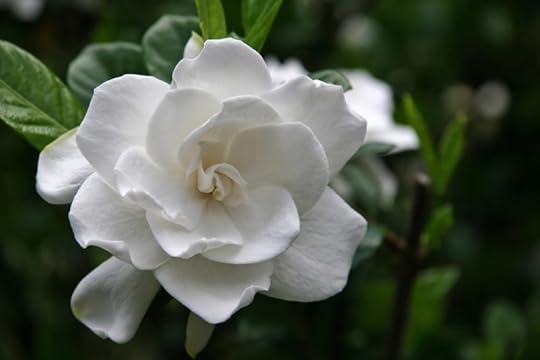 Gardenia
Gardenia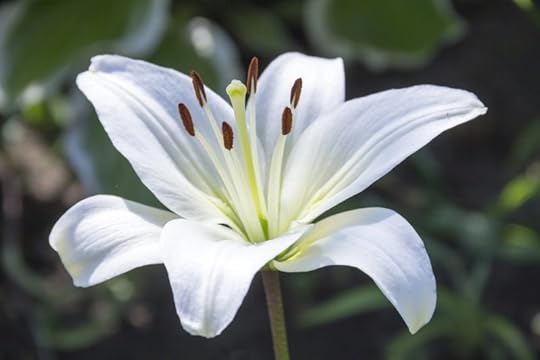 Lily
LilyThe Language of Flowers is particularly well-suited to my characters Father Joseph Lazare and Tessa Stratford: not only are they both gardeners, they are also secret lovers. When they first meet in Necessary Sins, Tessa is wearing a pink camellia in her hair. Camellias mean “my destiny is in your hands.” When Joseph and Tessa finally admit their forbidden love for each other, she’s wearing a lilac-colored gown. Because they need colder winters, lilacs don’t grow well in coastal South Carolina; but I liked their meanings, and using lilac as a color was a way to include them. Lilacs signify: the first emotion of love, the beautiful sadness of love, and impending farewell—all of which apply to Joseph and Tessa in that scene.
 Pink camellia
Pink camellia Lilac blooms
Lilac bloomsWith a family saga, I love to have symbolism that carries throughout the series and works for multiple characters. I was able to accomplish this in the two kinds of Noisette roses Tessa grows in her Church Street garden in Charleston. The first is a white Lamarque rose and the second is a multi-colored, peach-pink Jaune Desprez. For both Tessa and her daughter, these white roses live up to their “secrecy and silence” and “eternal love” meanings in what they witness, while the pink roses fulfill their promise of “perfect happiness.”
This image of a Lamarque rose dates back to the 19th century and can be downloaded from Wikimedia Commons here.
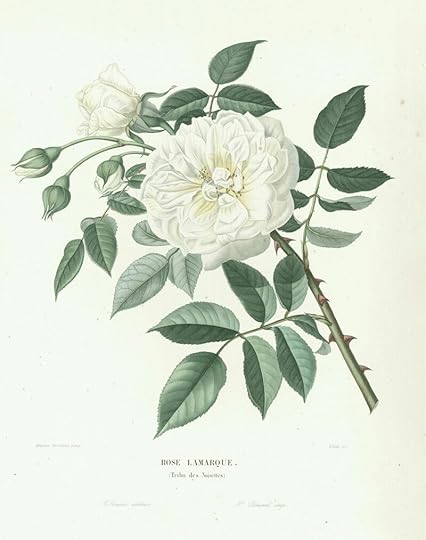
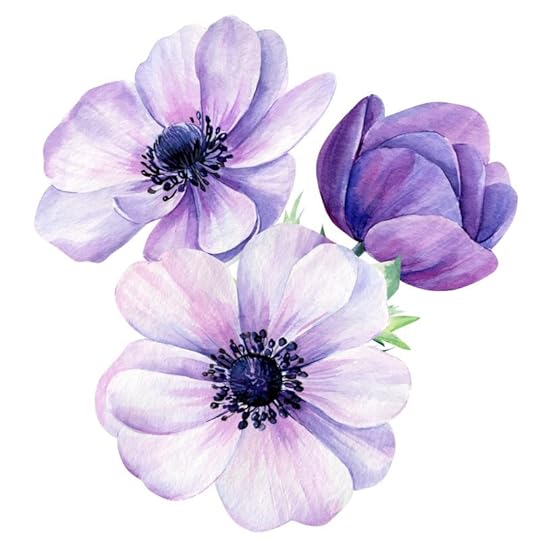
When a character suffers a miscarriage, she is painting flowers. I chose anemones because they mean “abandonment”; from the woman’s point-of-view, her child is abandoning her. Likewise, I associate dogwoods with her miscarriages (sadly plural) because dogwoods mean endurance and “love undiminished by adversity.”
 Pink and white dogwood trees in bloom
Pink and white dogwood trees in bloomNot all of the plants in Victorian flower dictionaries are actually flowers; some are other parts of plants. One is myrrh. This is a dried resin (similar to sap) from Middle Eastern trees in the genus Commiphore. Myrrh signifies gladness. Joseph burns it in his incense thurible during prayers, and he compares the color of Tessa’s hair to myrrh.
Sage is another plant that isn’t prized primarily for its flowers. I gave a character sage-green eyes for multiple reasons. Firstly, it reminds us of his home in the American West. Secondly, sage has powerful meanings in Victorian flower dictionaries—even if the writers were referring to culinary sage (Salvia) and not the sage of the arid West (Artemisia). Fortunately, both plants are a lovely silver-green. Sage signifies domestic virtue (the character is a faithful and supportive husband), wisdom (from the Cheyenne culture that raised him), and skill (in training horses and ahem, in bed).
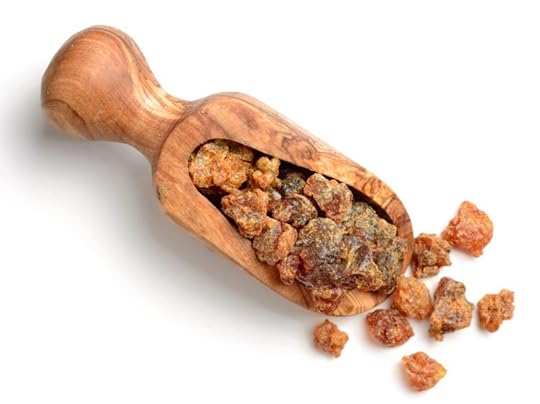 Myrrh
Myrrh Salvia officinalis
Salvia officinalisSometimes, I veer from Victorian meanings in the way I use flowers. For example, when this character from the American West is reunited with his long-lost family in the American South, I have them embrace in a garden “between the columbines and the azaleas.” To me, columbines are emblematic of the West. They’re the state flower of Colorado where I grew up—Cheyenne country—but columbines grow well in South Carolina too. Azaleas, meanwhile, do not grow in arid Cheyenne country, but they are found throughout the South.
 Blue Columbine, the state flower of Colorado
Blue Columbine, the state flower of Colorado A blooming pink azalea bush
A blooming pink azalea bushIn a surgery scene set outdoors, I mention yellow jessamine, also called Carolina jasmine. Though beautiful and native to the American South, jessamine is highly poisonous if you ingest any part of the plant. To the Victorians, jessamine meant “separation.” Both the literal and symbolic aspects of jessamine foreshadow that this surgery will have a dire outcome.

After Joseph hears Edward Stratford’s first confession and they go to meet Tessa in the Biblical garden, Joseph notices “a weed threatening his Passiflora.” In addition to the Catholic meanings I describe in Necessary Sins, passion flowers also signify romantic passion—and Edward, who will marry Tessa and be a terrible husband, is threatening Joseph and Tessa’s mutual passion. In using the Latin name for passion flowers, I was trying to be surreptitious about calling Edward a weed. 

Symbolic flowers appear on each of my print covers as well, on both the front covers and the spines of my paperbacks and hardbacks. These flowers are:
A peach-colored rose on Necessary Sins, representing a Jaune Desprez.A pomegranate blossom on Lost Saints. Joseph reflects on how a pomegranate was either the Tree of Life or the forbidden Tree of Knowledge in the Garden of Eden.A passion flower on Native Stranger.A forget-me-not on Sweet Medicine, foreshadowing a major character death in the final book of the Lazare Family Saga.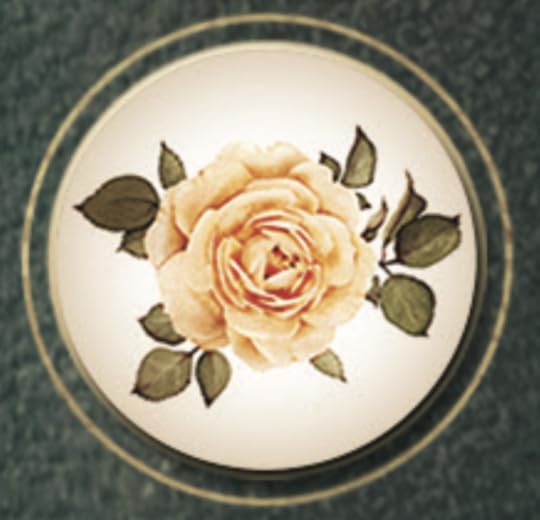
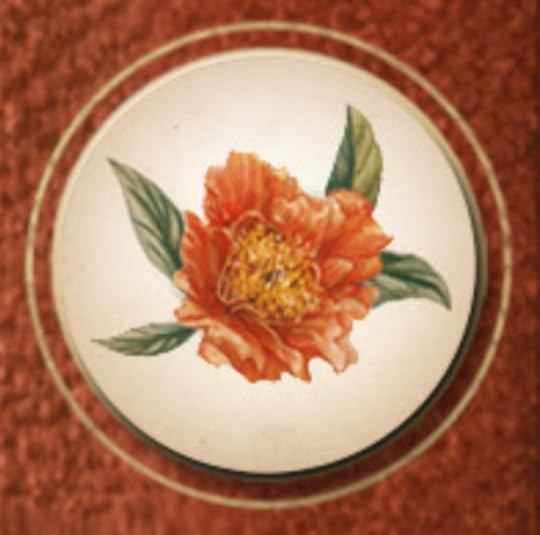
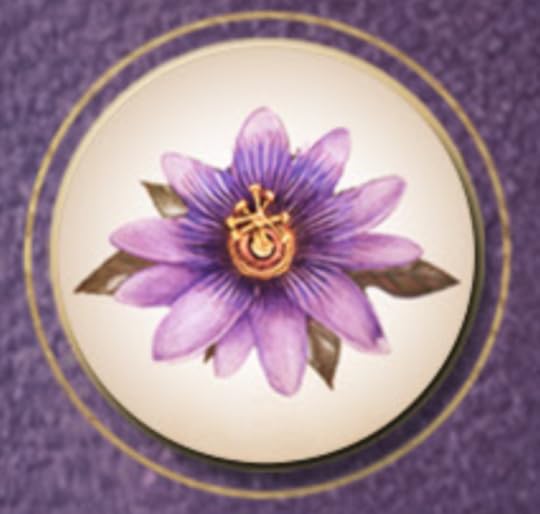

Flowers symbolize the brevity of life and beauty, but they also symbolize resurrection: they are reborn every year. I hope you’ve enjoyed this sampling of flower meanings as well as the flower images—and I hope something is blooming near you right now.
Do you know the meanings of your favorite flowers? Many Victorian flower dictionaries have been digitized. Here’s one published in Philadelphia in 1848. The two secondary sources I used most often were Tussie-Mussies: The Victorian Art of Expressing Yourself in the Language of Flowers (1993) by Geraldine Adamich Laufer and The Meaning of Flowers: Myth, Language, & Lore (1998) by Gretchen Scoble and Ann Field.
The post The Language of Flowers first appeared on Elizabeth Bell, Author.April 14, 2024
My Creative Process
I am a “pantser,” not a plotter. This means I write “by the seat of my pants” and do not use an outline. Back in school, when we were supposed to write an outline for an essay, I’d write the essay first, then the outline. I’ve always hated them! For me, structure strangles creativity instead of inspiring it. Above all, I don’t know where I’m going till I get there. I write by listening to my characters. But it’s not as if I sit down at my desk and they speak to me without any effort on my part. At least 60% of my writing time is research: reading the hundreds of resources that help me understand the world I’m (re)creating.
In his book On Writing, Stephen King says “stories are found things, like fossils in the ground…part of an undiscovered, pre-existing world.” This certainly describes my process. I’ve always felt that my stories already existed in some nebulous other dimension; I “just” had to find them.

But I didn’t start out with the skull of the buried Tyrannosaurus Rex. I’d find a single vertebra, maybe a claw. It was years before I could see the shape of the whole. I began by recording what the characters gave me as it “came through,” almost always starting with dialogue. These conversations were completely out of order, like bones jumbled in a box. In The Outlandish Companion, Diana Gabaldon says she does this too: “I also don’t write in a straight line; I write in lots of little pieces and then glue them together, like a jigsaw puzzle.”
Once I’d found the pivotal pieces, a kind of outline took shape in my head. About 2004, I wrote the first draft of the final scenes in my four-book family saga; I’ve known how it would end for a long time, who would not survive the narrative and who would achieve a bittersweet happiness. I knew the saga’s major events. But getting from Point A to Point B to Point C, etc. all the way to the end was quite a challenge. Often the puzzle pieces didn’t fit because I hadn’t yet found them all or because I’d found pieces of other, inferior stories (i.e. most of my early drafts with characters who ended up on the cutting room floor). Only in my last draft did I write the scenes in order, chapter by chapter, not moving on to Chapter 2 till I was satisfied with Chapter 1, etc.

Alice Walker and Kathleen Grissom have both said their characters speak to them like mine do. While I don’t actually believe I’m channelling spirits, there is something otherworldly about writing for me. In one of his autobiographies, Sidney Poitier talks about tapping into a universal consciousness in acting. Occasionally, I have found myself writing with seeming authority about things I definitely haven’t experienced and cannot remember studying. A cynic would say I did learn about them at some point but I’ve forgotten; this knowledge was simply waiting in my subconscious until I needed it. I’m not so sure.
I recently watched a YouTube video by author Michael La Ronn in which he discusses Dean Wesley Smith’s book about writing without an outline, Writing into the Dark. La Ronn says: “For me, writing is sacred. It’s as sacred as prayer. When I sit down and write and simply trust my creative voice and have full faith in it, I’m connecting with something higher than myself.” I got goosebumps. I understood completely. Inspired by Writing into the Dark, several people in one of my Facebook author groups decided that instead of pantsers, we want to be called “dark writers”—which is especially appropriate for me, who writes best when it’s dark outside!
I need quiet to write, to commune with my characters and fully enter their world. I have writing friends who can write on trains or in busy coffee shops. That doesn’t work for me. My ideal writing setup would be a sensory deprivation chamber! Financial constraints have meant I’ve always lived with family or roommates. So in order to find the quiet I needed, I did most of my writing after everyone else had gone to bed, between 10 pm and 4 am. (As I type this, it is 2 am.)

This late-night writing plus a genetic predisposition has given me a sleep disorder called Delayed Sleep Phase Disorder. Now, even when I’m not writing, no matter what medications I take or what habits I change, I cannot fall asleep before 4 am, and I can’t wake up refreshed before 1 pm. A sleep doctor said I’m “hard-wired” to this schedule; I seem to be stuck this way, like a sci-fi character trapped on a parallel plane of existence.
So I would not recommend my writing process to anyone who wants to be healthy or successful. A sleep disorder that rules your life isn’t something I’d wish on my worst enemy. Authors who use outlines and can “write to market” have a much easier time finding readers. I may also be the slowest writer on the planet. I wish I could write in the midst of distractions and that I had more to show for the three decades I’ve had my nose to the grindstone. But I cannot despise my process, because it gave life to characters I love and to four complex books that are my pride and joy.
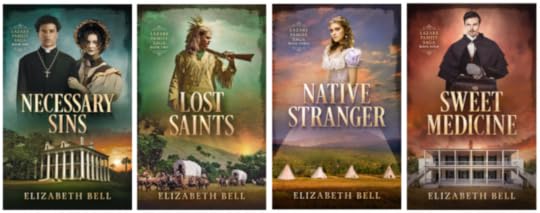
Here’s another way I described my creative process of writing historical fiction to a reader:
Research till your pores exude truths about your chosen period. Make your story fit those truths more often than you tweak the truths to fit your story. Write a few sentences and realize you still don’t know nearly enough about ____ to write about it. Return to your research. When you feel you’ve reached critical mass on research, take several days off your paying job and turn off the world, including phone, text, email, and social media. Especially social media. Realize you still need to know more about ____. Order articles and books from your library about ____ and forge ahead as best you can till they arrive. Use the internet only for research. Forgo sleep and meals as your characters demand attention. Drag yourself to your paying job. After you get home from work each day, read your new research materials, fill in the missing details, and revise. The next time you can get a block of days off your paying job, repeat.
Now you know why The Lazare Family Saga took me three decades to write.
The post My Creative Process first appeared on Elizabeth Bell, Author.March 15, 2024
For the Love of Critters
One of my characters, Clare Stratford, is a Southern belle. When she falls in love, however, she considers spending the rest of her life as a Cheyenne Indian. So I knew she couldn’t be prone to “the vapors”; she had to be fearless and in touch with the natural world. Therefore, I gave Clare my own love of animals.
In this post, I thought I’d share a few of the critters who fascinate both myself and Clare. Fortunately, South Carolina shares a lot of wildlife with Virginia, where I’ve lived since 2004. (For the squeamish: there will be a small snake.)
At the South Carolina Female Collegiate Institute—a real school—young Clare attracts the ire of the “mean girls” because of her Catholicism and her eccentric ways. The girls nickname Clare Turtle Girl after she helps a box turtle (Terrapene carolina) cross the road. Here’s a box turtle I helped cross a road near my home in the Northern Virginia woods. Because I’m an introvert and such a slow, deliberate writer, I have a special affinity with turtles.
 Turtle helper tip: Always advance the turtle in the direction he was going. Otherwise, he’ll simply try to cross the road again after you leave!
Turtle helper tip: Always advance the turtle in the direction he was going. Otherwise, he’ll simply try to cross the road again after you leave!In Chapter 3 of Native Stranger, Clare finds a baby ringneck snake (Diadophis punctatus) trapped in a spider’s web. This was inspired by a true event. I was fascinated by the seeming contradiction of a snake being caught by an insect.
Like Clare, I dislike spiders, but I am overrun by them in my basement apartment. So I set out glue traps—but a few times a year, especially when we get heavy rains, I catch ringneck snakes instead. Once, I caught nine snakes in two traps! They must have been siblings.
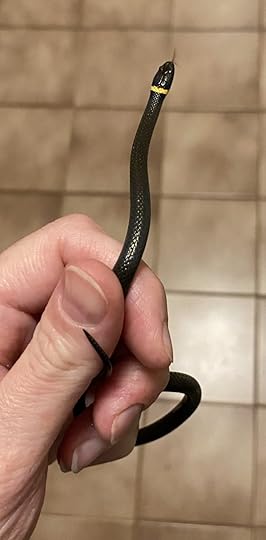
Fortunately, a little vegetable oil to dissolve the glue quickly frees them, and ringneck snakes are harmless to humans. This one is an adult—they average only 12 inches long—so you can imagine how tiny a hatchling is.
I use snakes as a symbol in my fiction, a symbol with multiple meanings. Did you know Prince Albert gave Queen Victoria a snake engagement ring? To the Victorians, the animal meant eternal love and commitment. If you’ve read Lost Saints, you may remember that Clare has an ouroboros bracelet.
An ouroboros is a snake eating its own tail, an ancient symbol of rebirth, which is a motif in my saga. It’s why I named the central family Lazare, after the Biblical man who rose from the dead. But of course, snakes can be deadly, too.
Finally, the creature that I’ve come to know best is the Monarch butterfly (Danaus plexippus). Here I am at age six with one on my nose. As soon as I figured out that caterpillars were easier to catch than butterflies, I began raising Monarchs.
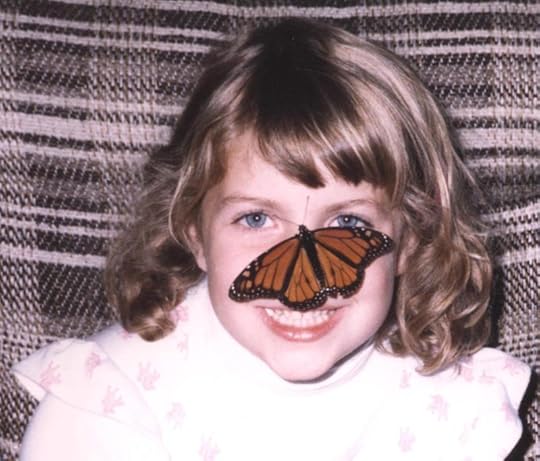
I find the eggs or caterpillars on milkweed—their only food source. Then, like Clare does in Chapter 4 of Native Stranger, I watch in fascination as they undergo their metamorphosis, becoming chrysalises and finally adult butterflies. I must have raised and released over a thousand Monarchs across the years.
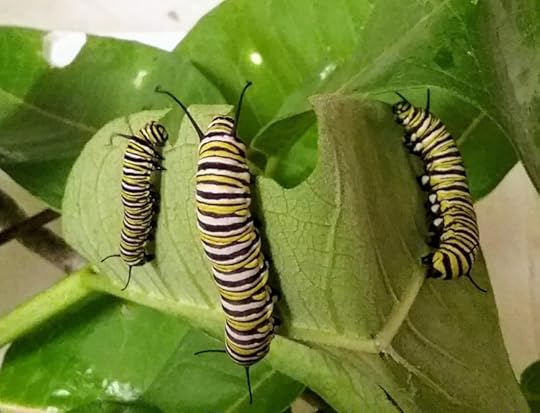 Three Monarch caterpillars happily munching milkweed
Three Monarch caterpillars happily munching milkweed
A chrysalis I found in the wild. Monarch chrysalises are jade green with stunning gold accents.
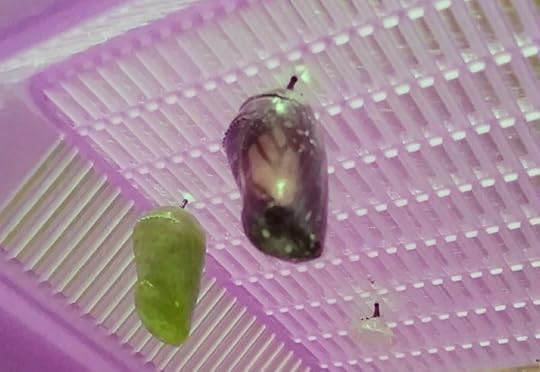
The chrysalis at right is about to “pop” (the technical term is eclose), with the orange-and-black wings of the butterfly clearly visible through the transparent case.
Butterflies are another symbol of rebirth in my work. There’s a Monarch butterfly in the stained glass of the Lazare mausoleum, and my character Ésh dreams about a Monarch. I decided to feature this beautiful little creature on the back cover of the print version of Native Stranger.

Those are just the critters for whom I have my own decent photos! Other wild creatures featured in The Lazare Family Saga include:
 Pronghorn (called antelope in the 1800s)
Pronghorn (called antelope in the 1800s) Prairie dogs
Prairie dogs Black wolf
Black wolfNot to mention a badger, a great-horned owl, and domestic animals like cats and horses, one of whom you’ll spot on the cover above. A tiny tuxedo cat also appears on the ebook and audiobook covers of Sweet Medicine, and the print version of Lost Saints features a bison (buffalo) calf with its mother. They symbolize Ésh and his Cheyenne mother, Zeyá.

What’s your favorite animal?
The post For the Love of Critters first appeared on Elizabeth Bell, Author.February 14, 2024
The Art Over My Desk
Above my messy writer’s desk overflowing with research materials, I hung three works of art that helped inspire my historical family saga with strong romantic elements. Let’s take a closer look.
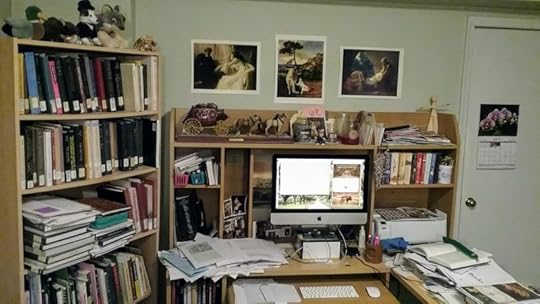

Frank Dicksee’s The Confession (1896), a Victorian problem picture with multiple possible meanings. Is the man the woman’s husband or her priest? Which one of them is confessing, and what is (s)he confessing? Maybe this isn’t a couple at all…or maybe the priest is her lover. 
(Image links to its source, Gallerix)
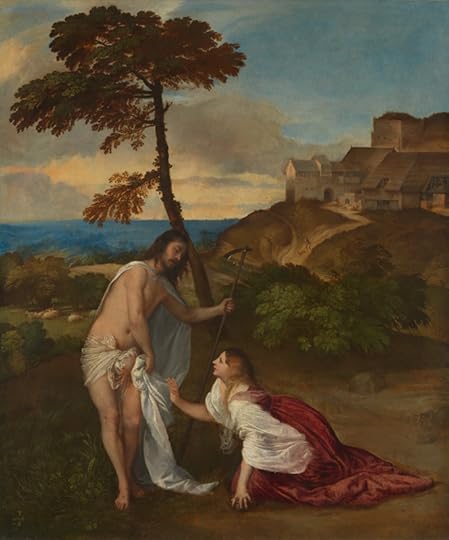
Titian’s Noli Me Tangere (circa 1514). If you’ve read Necessary Sins, you know a copy of this painting hangs in René Lazare’s office. This image captures a moment from the Gospel of John (20:17) in which Jesus appears to Mary Magdalene after His resurrection. She reaches for Him, and Jesus responds “Do not touch me,” or “Noli me tangere” in Latin.
This meeting is a popular subject in Christian art. What I like about Titian’s version is the frisson of intimacy between the couple. Some people believe Jesus and Mary Magdalene were married. I couldn’t have a character as unconventional as René or as dogmatic as his son Joseph and not raise the possibility.
(Image links to its source, The National Gallery UK)
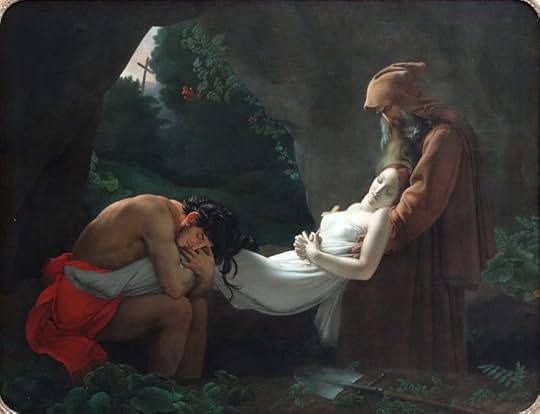
Last but probably my favorite artistically: Anne-Louis Girodet de Roussy-Trioson’s The Entombment of Atala (1808), based on an 1801 novella by François-René de Chateaubriand. I adore these French names too!
Chateaubriand’s novella takes place in 17th-century Louisiana. Despite her fair features in the painting, Atala’s father is a Christian Spaniard and her mother is a Christian Indian. Chactas is an Indian from an enemy tribe and a “pagan.” Atala and Chactas fall in love, but she promised her dying mother that she would remain a virgin and a Christian. Unable to reconcile her religious and earthly passions, Atala kills herself. In this scene, Chactas and his friend Father Aubry lower Atala into her grave.
An earlier scene in Atala makes an appearance in Necessary Sins as depicted on a gilded clock. In this painting, I love Girodet’s use of light, color, and body language. I can feel Chactas’s grief.
(Image links to its source, Wikimedia Commons)
These paintings all share a common theme that features in my own fiction: tragic love. I do enjoy a good romance novel with a guaranteed HEA (Happily Ever After). But tragic and bittersweet love stories stick with me even more. When characters endure purgatory and earn their earthly heaven, it’s so satisfying. And when the couple doesn’t achieve a happy ending, I still find the “might have been” delicious. For a few precious days/years/chapters, the characters found joy together and they were not alone.
The post The Art Over My Desk first appeared on Elizabeth Bell, Author.January 22, 2024
Alternate Opening / Deleted Scene
It took me nearly three decades to write the four-book Lazare Family Saga. Over these years, I wrote at least a dozen opening scenes, set in different places and times in the point-of-view of different characters. Where does this story begin? I kept asking myself and exploring different answers. Here’s an alternate opening scene that I thought might be the winner:

Charleston, South Carolina
October 1791
Light, light, LIGHT! her thumping heart seemed to scream in her ears. In her haste, Marguerite dropped the candlestick. It clattered over the hearth, yet René did not stir. Had her dream not been a dream?
Marguerite fumbled for the candle and thrust its end into the embers till the wick caught. She shielded the flame with her hand and rushed around her bed. She brought the candle as close as she dared to René’s crib, till its glow revealed his dark curls and sleeping face.
At last Marguerite could breathe. He was here. He was safe. He was hers.
Of course René’s mother had not come for him. Even if Marguerite hadn’t killed her, the girl could not possibly know where he was. Half an ocean separated them. Even if the girl pounded on the door this very moment, no one would listen to her. She couldn’t speak French, let alone English. Most of all, she was only a slave.
In the candlelight, René’s skin looked nearly as white as his pillow. He belonged here with Marguerite. She was a respectable émigrée, a baroness. She could give him the life he deserved. She was his grandmother, the only mother he would ever need. If René had not forgotten that turbaned mulâtresse already, he would soon enough.
If only Marguerite could forget her.
NotesMarguerite’s choices set the rest of The Lazare Family Saga in motion. But Marguerite is a difficult character. She’s necessary, but she’s not supposed to be sympathetic. I had beta readers tell me they didn’t know who to root for because they didn’t like anyone in Marguerite’s scenes.
So this opening scene was a little trick to get you on Marguerite’s side—and then yank the rug out from under you when you realize she’s kidnapped this child she’s so worried about. I suppose it’s my thriller opening.
Part of me regrets losing this scene. But Necessary Sins really belongs to Marguerite’s great-grandson Joseph, and finally I decided I should begin with him. Here’s the published version of The Lazare Family Saga’s opening scene. Do you think I made the right choice?
The post Alternate Opening / Deleted Scene first appeared on Elizabeth Bell, Author.January 8, 2024
Flashback: The Year It All Began
Over the next few months, I’ll be reviving some of my most substantial, evergreen newsletters as blog posts so that anyone can read them. And so it begins!
The year was 1994. Schindler’s List won the Best Picture Oscar. Jeff Bezos founded Amazon. (Remember the days when it sold only books and you got a free bookmark with every order? I do!) I turned fourteen and entered my Freshman year of high school.
I also started writing a historical saga about a family on the Oregon Trail who became separated from the rest of their wagon train. In the past, I’d written novellas in journals with pretty covers, but I could already predict that the new story would be epic in scale. I knew I’d need more pages than a slim journal, so I decided on a Mead notebook: fat, lined, and spiral—boring but utilitarian.
 * Not actual footage of fourteen-year-old me *
* Not actual footage of fourteen-year-old me *I didn’t yet have a computer. I did have a Brother word processor with a narrow green screen, essentially a typewriter that let you save your work on floppy disks. I liked to write my first drafts longhand so that I’d be forced to go over every word as I inputted the second draft into the word processor.
Little did I know just how many drafts I’d write of my historical epic… I’ve lost count, and it depends on the scene in question. I’ve easily rewritten some parts twenty times, and they would take up the next three decades of my life.
 I think my screen was even narrower!
I think my screen was even narrower!I used a bunch of pretty journals after all but to hold my research notes. So many research notes, on everything from the Haitian Revolution to celibacy to Egyptian Revival architecture to Charleston gardens to slavery to horseback riding to blood transfusions to corsets to Cheyenne Indians. For a selected bibliography, check out this page.
Back in 1994, I thought I was writing a single, albeit doorstopper-sized, novel. In its final form, the Lazare Family Saga is four fat books and more than half a million meticulously researched, finely polished words.
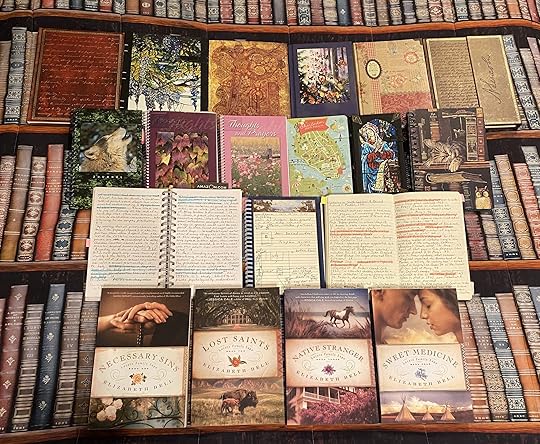 Fifteen journals full of research notes and the four epic historical novels that grew out of them. If you look closely, you’ll see an original Amazon bookmark peeking from one journal! (That’s my Victorian library comforter underneath.) [image error]Fifteen journals full of research notes and the four epic historical novels that grew out of them. If you look closely, you’ll see an original Amazon bookmark peeking from one journal! (That’s my Victorian library comforter underneath.) [image error]Fifteen journals full of research notes and the four epic historical novels that grew out of them. If you look closely, you’ll see an original Amazon bookmark peeking from one journal! (That’s my Victorian library comforter underneath.)
Fifteen journals full of research notes and the four epic historical novels that grew out of them. If you look closely, you’ll see an original Amazon bookmark peeking from one journal! (That’s my Victorian library comforter underneath.) [image error]Fifteen journals full of research notes and the four epic historical novels that grew out of them. If you look closely, you’ll see an original Amazon bookmark peeking from one journal! (That’s my Victorian library comforter underneath.) [image error]Fifteen journals full of research notes and the four epic historical novels that grew out of them. If you look closely, you’ll see an original Amazon bookmark peeking from one journal! (That’s my Victorian library comforter underneath.) Many, many times over the years, I doubted I would ever finish this project. I couldn’t figure out where the story began—or where it ended. If I did A, could I also do B, or were those choices mutually exclusive? My characters wouldn’t stop talking; scene after scene came to me, but how would I ever stitch them together? I was terrified that even if I managed to start well and the middle was strong, the saga would end with a whimper.
After nearly three decades, when I typed the final words (this time on an iMac), I knew I’d pulled it off. I reached my mountaintop with a little help from my writing friends: my critique partners, beta readers, and editor, who gave me fantastic feedback and kept me from getting lost along the way. Those final words exist because of my editor in particular, who suggested closing with René’s point-of-view. When she read the new Epilogue, she said: “You absolutely nailed this. Way to tie it all together. This ending is nothing short of spectacular.”
Exactly what an author wants to hear.
The post Flashback: The Year It All Began first appeared on Elizabeth Bell, Author.January 1, 2023
My Debt to Colonial Williamsburg
Most of my Lazare Family Saga series takes place in the 19th century, so you might think visits to an 18th-century living history museum wouldn’t be terribly useful to my research. In fact, Colonial Williamsburg in Virginia was one of the richest sources for my fiction set mostly in 19th-century South Carolina. Here’s how!
After I moved to Virginia in 2004, I visited Colonial Williamsburg as often as I could and absorbed its historical delights like a sponge. This is how I read nonfiction as well; I rarely know which details will be useful, even crucial, in my historical fiction, so I devour them all. Finally, I had to cut myself off from travelling, finish writing my Lazare Family Saga, and publish it. Then COVID hit. It’s been six years since I last visited Colonial Williamsburg.
I remedied that in December 2022. Before, I’d always stayed “on the cheap.” For the first time, I was able to rent one of the Historic Area’s Colonial Houses: a restored 18th-century kitchen with a working fireplace and a canopy bed. I’d never slept in one before, and I loved its coziness.
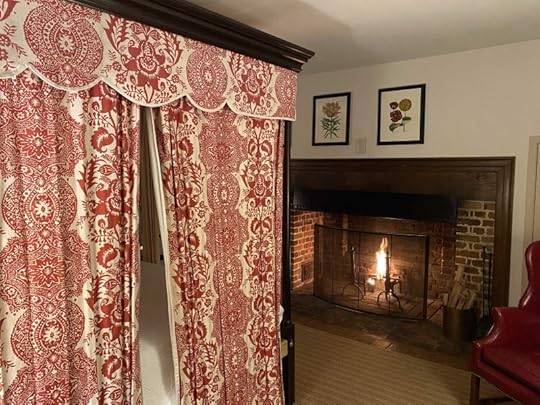 My cozy canopy bed and fireplace inside the Market Square Kitchen, a restored 18th-century building and one of the Colonial Houses in Williamsburg. Joseph and Tessa could be hiding behind the bed curtains!
My cozy canopy bed and fireplace inside the Market Square Kitchen, a restored 18th-century building and one of the Colonial Houses in Williamsburg. Joseph and Tessa could be hiding behind the bed curtains!My visit reminded me of all the reasons I love Colonial Williamsburg. To me, its two greatest aspects are ones I hope I’ve recreated in my historical fiction: Colonial Williamsburg awes me with both its scale and its depth. The Historic Area isn’t just a handful of restored or reconstructed 18th-century buildings. It’s the largest living history museum in the world: 301 acres and 604 buildings—truly an epic recreation of the past. The people who interpret these spaces often spend decades researching their characters and unearthing forgotten details from primary sources. In the Historic Trades, master craftsmen must apprentice for seven years just as they did in the 18th century.
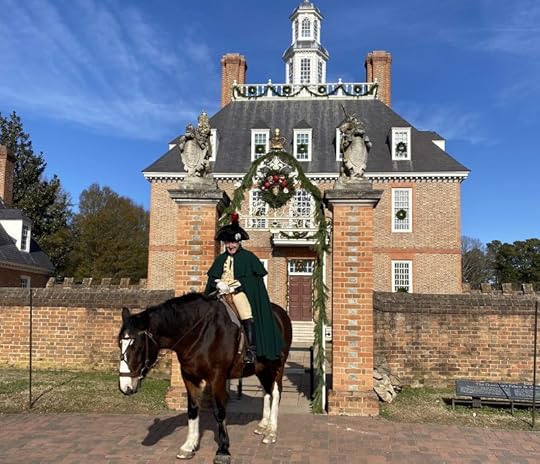 Lafayette outside the Governor’s Palace
Lafayette outside the Governor’s Palace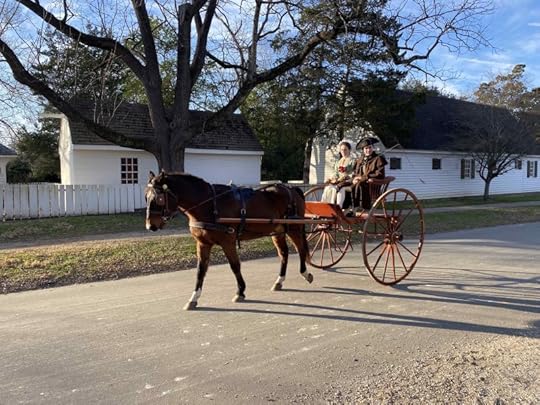 Martha and George Washington
Martha and George WashingtonThese interpreters’ dedication inspires me as a writer. Colonial Williamsburg was the foil that allowed me to see and correct the gaps in my 19th-century knowledge. Because CW interpreters know daily 18th-century life so thoroughly, they challenged me to think about my characters’ primary century in new ways.
My Lazare Family Saga does begin in the 18th century, albeit in the last decade and in the Caribbean, not in Virginia. Nevertheless, when Marguerite dons a detached pocket (Necessary Sins, Chapter 4), this comes straight from my visit to the milliner’s shop in Colonial Williamsburg. The wigmaker helped me understand that curious fashion. Cooking over an open fire as Sarah and Easter do didn’t change much from the 1700s to the 1800s. Nor did blacksmithing.
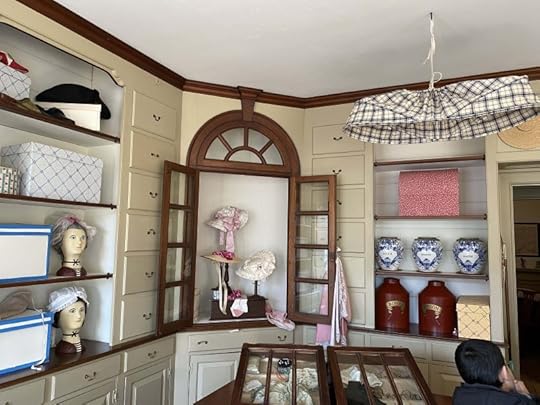 Milliner’s shop
Milliner’s shop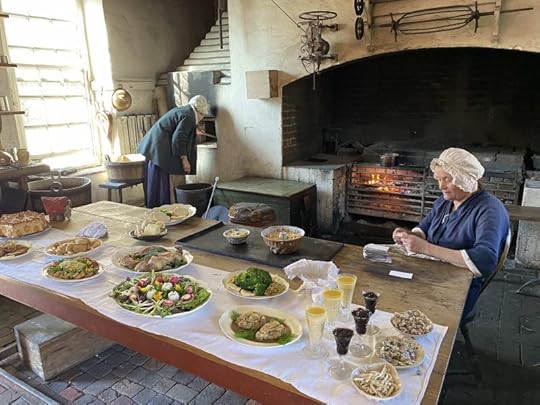 Governor’s Palace Kitchen
Governor’s Palace KitchenHappily, many of the objects displayed in the Art Museums of Colonial Williamsburg are from the 19th century. I studied several examples of men’s neckwear to describe Joseph’s (Necessary Sins, Chapter 21). Tessa’s brown cloak with white lining in Chapter 29 was based on a cloak I saw in the CW Museums as well.
I researched The Lazare Family Saga for so many years and visited Colonial Williamsburg so many times, I can’t always parse chicken from egg: Did I read about Noah’s Ark toys (Lost Saints, Chapter 11) in a book before I saw a complete set in the CW Museums? I think I researched 19th-century couches online and chose the perfect shape for Tessa’s méridienne before I spotted one on display in the Museums—but having that real-life example helped tremendously and directly inspired the tasselled pillow I mention in Lost Saints, Chapter 8.
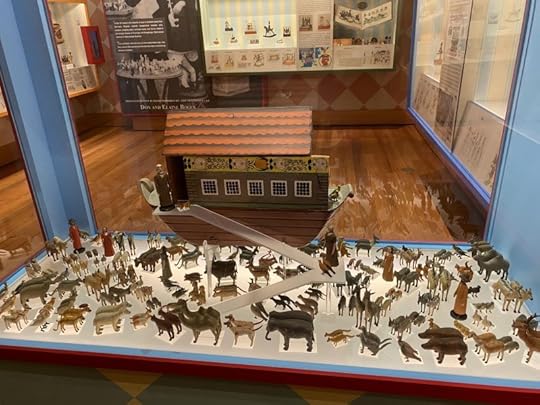 A late 1800s Noah’s Ark toy set
A late 1800s Noah’s Ark toy set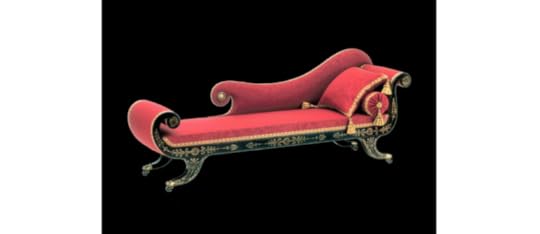 A circa 1820 couch shaped like Tessa’s green mérdienne
A circa 1820 couch shaped like Tessa’s green mérdiennehttps://emuseum.history.org/objects/6...#
The most iconic tree of the antebellum American South is the live oak (Quercus virginiana). These don’t grow in Northern Virginia where I live; but they do grow in Williamsburg! The Colonial Garden may be the first place I saw pomegranate blossoms. I know it’s where I learned about cold frames (Necessary Sins, Chapter 17). What might a man of science have in his office? How does one climb into a carriage? CW answered these questions.
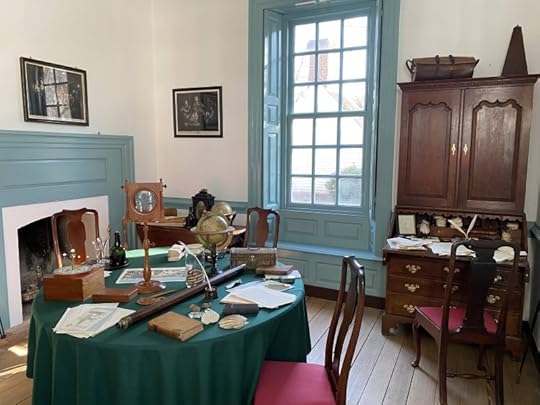 George Wythe’s office. Note the portmanteau and microscope case atop the desk at right
George Wythe’s office. Note the portmanteau and microscope case atop the desk at right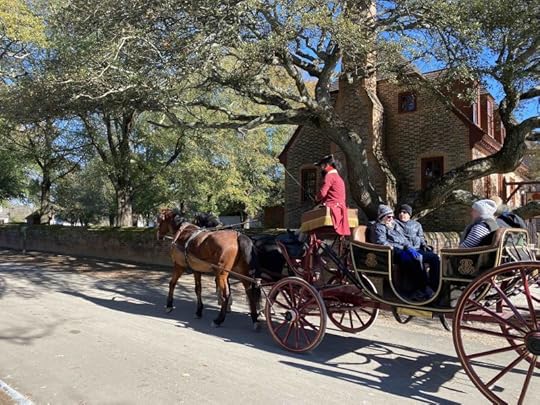 One of Colonial Williamsburg’s live oaks and tourists in a carriage
One of Colonial Williamsburg’s live oaks and tourists in a carriageOn my tour of the Randolph property, I learned about an enslaved maid named Eve, inspiring me to give René’s mother the French version, Ève, for her slave name (Necessary Sins, Chapter 1). The real-life Eve escaped slavery as well. Tragically, she was recaptured and sold to the West Indies as punishment.
In Chapter 6 of Necessary Sins, the racist Marguerite commands her grandson Joseph: “Don’t you ever trust a negro with your shaving razor!” This remark was inspired by a walking tour of Colonial Williamsburg that discussed the enslaved population. Our guide gave personal grooming, including shaving razors, as an example of how intimately the lives of enslavers and enslaved intertwined.
On a visit to CW’s Great Hopes Plantation (sadly this site seems to be closed now), I saw a modern blacksmith’s recreation of a slave collar. I combined this atrocious design with a slave collar I’d seen in a Louisiana museum in order to describe such a collar in Chapter 9 of Necessary Sins. In Chapter 40 of Native Stranger, Cromwell mocks Easter for eating too many ginger cakes. Every time I visit CW, I do exactly this.

Colonial Williamsburg is truly hands-on history, and these are some of the ways it’s had a profound impact on my historical fiction. I can hardly wait to return.
The post My Debt to Colonial Williamsburg first appeared on Elizabeth Bell, Author.October 29, 2022
Character Art!
I’ve spent three decades with the characters of The Lazare Family Saga. They are dear to me, and it’s long bothered me that I had only stock photos to represent my book children visually. When you’re working with existing images, nuance and individuality are lost.
Then a few months ago, an author friend—the marvelous Susie Murphy—shared character art she’d commissioned of her central couple, Bridget and Cormac. Susie’s beautiful, unique book babies, captured in a digital painting! I loved it!
I was also envious. Could I do the same: commission my own character art? It seemed an extravagance. But hey, as an indie author, I could count the artwork as a business expense and try it as a marketing image. I investigated the artist Susie had used and several others. (Tip: Artists tend to follow other artists on social media.) I found many stunning talents. However, most of these artists were currently closed to commissions, and most of them focused on fantasy characters.
The artist Susie had chosen ended up being the best fit for me too. Her name is Julia Jacob Mori, a.k.a. @artbyjuliajm, and she’s Brazilian. Her Instagram profile describes her as “Obsessed with history and cats.” Julia is actually writing her own interracial love stories set in the 1800s, and she understands 19th-century undergarments. A kindred spirit indeed! Better yet, Julia had space in her calendar, her price was reasonable, and she agreed to work with me.
I sent Julia oodles of information about my characters Joseph and Tessa, and Julia created this dreamy double portrait:
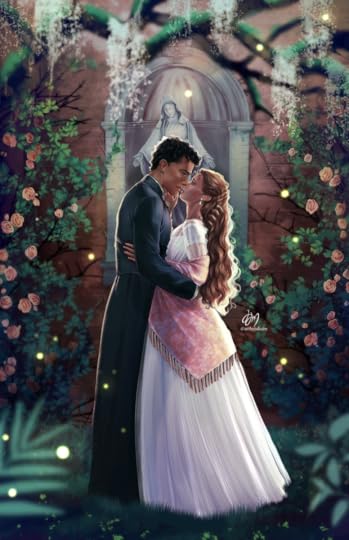
Julia’s digital painting doesn’t literally depict a scene from Necessary Sins or Lost Saints because Joseph never visits Tessa’s garden while wearing his soutane (cassock). I asked Julia to put one on him so that his priesthood would be apparent without a caption.
To reinforce my characters’ Catholicism, Julia included a statue of the Virgin Mary. Julia and I both felt wicked, having a priest canoodling with a woman in front of such a statue.  But to my eyes, the final effect isn’t wicked at all. Do you think the Virgin Mary is grieving for the forbidden lovers…or blessing them?
But to my eyes, the final effect isn’t wicked at all. Do you think the Virgin Mary is grieving for the forbidden lovers…or blessing them?
The fireflies were Julia’s idea, and I love them. They add to the atmosphere, as does the oak limb draped in Spanish moss. Julia beautifully captured the emotion of Joseph and Tessa’s secret meeting.
I loved Julia’s artwork of Joseph and Tessa so much, I decided I wanted her to illustrate a scene with Clare and Ésh as well. But her commission schedule was already booked up for months! I resigned myself to delayed gratification. And then, one of her commissions cancelled! She had an open spot and asked me if I was interested. I grabbed it!
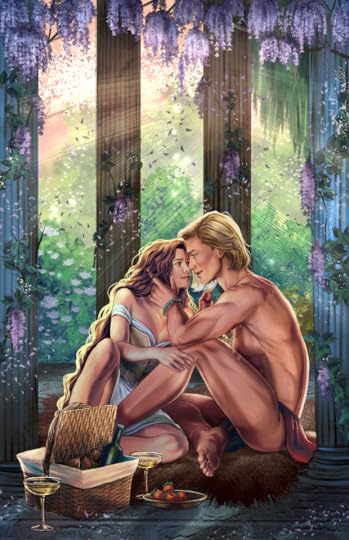
Next, Julia created this intimate portrait of “the next generation,” Clare and Ésh. My readers should recognize this as the wisteria pergola on Sullivan’s Island and Clare and Ésh’s naked picnic…except Julia added a few bits of clothing. 
Firstly, we wanted to convey the time period: the 19th century. Secondly, we wanted to convey Clare and Ésh’s very different backgrounds: she’s a Southern belle, and he’s lived almost all his life with the Cheyenne Indians. To do that, we needed some clothes—and this version is more Safe for Work.
Julia gave Ésh so many marvelous details from my story: his scars, his ouroboros bracelet, and the medicine pouch around his neck. But I think my favorite part of this image is the expression on Clare’s face—clearly a woman in love. Strawberries have nothing on Ésh!
Even better, Julia shared with me her process videos: how she created these digital paintings using the Procreate app. The time lapses are fascinating to watch! Take a peek:
What do you think of Julia’s art depicting my characters? Do they look how you imagined them? Should I have Julia paint anyone else?
The post Character Art! first appeared on Elizabeth Bell, Author.October 13, 2022
Now in Audio: The Complete Lazare Family Saga!
It is finished! My marvelous narrator and I have wrapped the fourth and final audiobook in The Lazare Family Saga, Sweet Medicine! Here are the stats for the complete series:
526,397 total words performed
222 final audio files
60.75 final audiobook hours
14 songs performed in 11 genres and 5 languages
(Ballad, opera aria, Latin plainchant, lullaby, African-American spiritual, juba chant, American minstrel, American folk, Irish traditional, and nursery rhyme in English, Italian, Latin, French, and Irish Gaelic)
13 major accents
(General American, Charleston, Cheyenne Indian, French, Irish, African-American, British RP, Italian, German, Haitian Creole, Rhotic Southern US, Western US, Scottish)
10 spoken languages
(English, Cheyenne, French, Latin, Irish Gaelic, Haitian Creole, Italian, Dakota, Arapaho, Yoruba)
9 months of auditions, prep, recording, and revision
(on the texts themselves, 29 years of research, writing, and revision before that)
4 fat historical novels
1 exceptional voice actor!
Click on the video preview below for a peek behind the scenes of the magic* happening!
*Magic = the superlative talent and hard work of my audiobook narrator, Dallin Bradford
Dallin is like the voice of God + the nicest guy you’ll ever meet + the sexiest man you’ll ever meet. Which was absolutely perfect for my series exploring, juxtaposing, and merging sexuality, spirituality, and nice guys.
I swear, sometimes Sweet Medicine sounds like a full-cast recording and not a single actor. I’ve got a smorgasbord of characters, but Dallin is that good. Not only did he capture the accents, energy, and emotions of my characters, it felt like he was channelling me, my inner narrative voice. He deserves a combat medal for Chapter 18, and he deserves an Audie Award for Chapter 29.
I was over the moon when Dallin sent me the following email during recording: “I just want you to know that, the other day, chapter 29 had me sobbing. I could hardly see the pages. I had to go hug my wife for a few minutes before going on.” At first, I wanted to apologize, but Dallin confirmed that he meant it as a compliment on the power of my writing. 
Since the reason I made my narrator cry would be too much of a spoiler, here’s another snippet from the Sweet Medicine audiobook, in which Dr. David Lazare does what he does best: undress Clare. 
If you’re new to my series, please start with Necessary Sins, Book One of The Lazare Family Saga. I’ve been thrilled with the reviews Dallin’s performance is receiving:
“SUPERB audiobook narrator. If you enjoy audiobooks, this is an absolute gem. There are about five million different accents and the narrator does them ALL. He also sings opera and Catholic hymns. I was absolutely transfixed by this performance.”
“I will be forever grateful to this book for instilling my new love of audiobooks. I had tried audio many times in the past without success but this book hooked me from the very beginning and it was an incredible listen.”
“Dallin Bradford’s performance was beyond exceptional. He did a great job keeping every character’s voice distinct. His accents were perfect for an audiobook – enough to get the flavor without forcing you to strain to understand him.”
“Dallin Bradford narrates a story with a voice full of emotion and a good sense of all the accents of the characters. It almost feels like he’s sitting down beside me with a glass of sweet tea to tell me the latest chapter in Joseph’s life.”
The complete Lazare Family Saga quartet is now available on Audible US, Audible UK, Audiobooks.com, Chirp, Kobo, Scribd, and all fine audiobook platforms. You can also recommend that your library purchase Necessary Sins and the rest of the series in audio. Here’s how to do that on Overdrive/Libby. Happy listening!
The post Now in Audio: The Complete Lazare Family Saga! first appeared on Elizabeth Bell, Author.October 3, 2022
Read or Listen for Free This Month!
Are you new to my historical fiction quartet, The Lazare Family Saga? Perhaps you’d like to revisit where it all began, now that I’ve made a few changes. I’ve got great news:
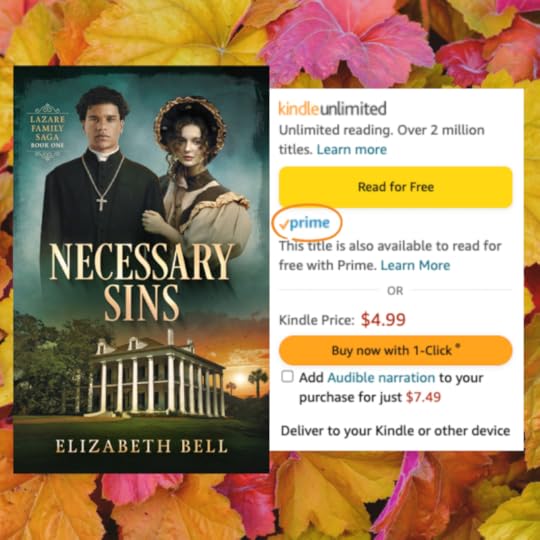 If you’re a U.S. member of Amazon Prime, the Kindle edition of Necessary Sins, Book One of The Lazare Family Saga, is free to read now through November 30th!
If you’re a U.S. member of Amazon Prime, the Kindle edition of Necessary Sins, Book One of The Lazare Family Saga, is free to read now through November 30th!Prefer the audiobook? I’ve also made the Necessary Sins audiobook free for the month of October! That’s how much I love my narrator’s performance: I want as many people as possible to hear it. Here’s how to claim the Necessary Sins audiobook: Sign up for a free NetGalley account and download the free NetGalley Shelf app.
Necessary Sins is set to Listen Now, which means you don’t have to wait for approval from the publisher (my NetGalley co-op, BooksGoSocial)—you can start listening instantly. If you download Necessary Sins to your NetGalley Shelf app, you can listen for up to a year.
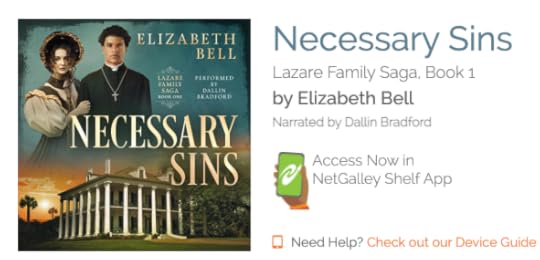 Click on the image above to go to the NetGalley listing!
Click on the image above to go to the NetGalley listing!If your library has Overdrive/Libby, you can also ask them to purchase my audiobooks. Here’s a help article, and here’s how I did it through my public library. Follow the gold stars in the images below!
1. Search for my audiobooks in your library’s Overdrive collection. I recommend searching by Lazare Family Saga or the book title rather than by Elizabeth Bell, which will give you lots of irrelevant results. You may need to broaden your search to “add titles the library doesn’t own.”
2. When you find Necessary Sins, click on the “RECOMMEND” option under the cover.
3. Fill in your email and hit the RECOMMEND button. If your library purchases my audiobook, you’ll have the first chance to borrow it!
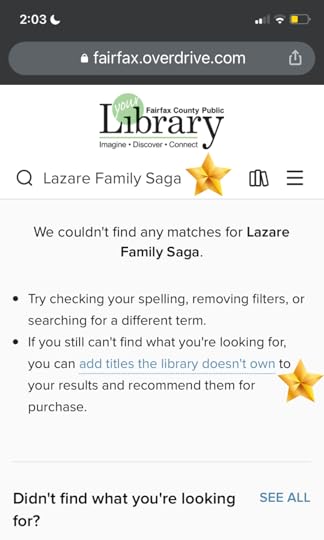

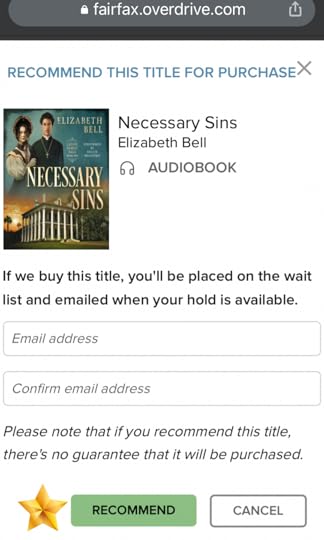
My library allows each patron to recommend only one book every 30 days, so you may need to wait before you can recommend th rest of The Lazare Family Saga: Lost Saints, Native Stranger, and Sweet Medicine.  Happy listening!
Happy listening!



